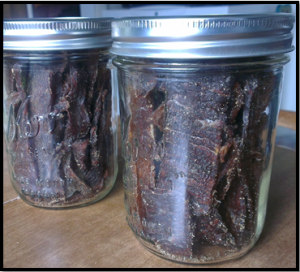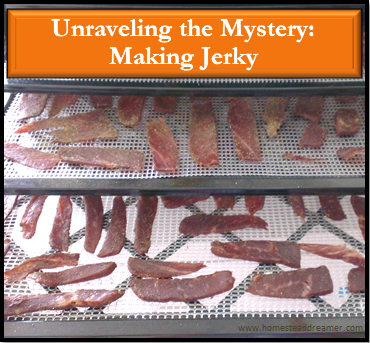I’ve been saving this one for awhile. I expect it may get a good amount of attention because, let’s face it, jerky is pretty much one of the best things on the planet, right? (Vegetarians and Vegans excluded, of course). Well, it also happens to be one of the easiest things to make yourself! It is pretty straightforward really: You are taking the moisture out of meat. Cavemen figured this stuff out as a way to preserve meat for winter so pretty much anyone can do it. The difference is we have loads of spices and plenty of salt to add, not to mention modern equipment such as smokers, dehydrators, and ovens to speed things along in larger batches. You might want to grab a cup of coffee for this one. It will likely be a lengthy post. 🙂
The Science of Making Jerky
The process of making jerky removes the moisture from the meat. Moisture is one of the 4 elements that makes food spoil: moisture, heat, air, and light. Essentially, you are dehydrating the meat, with the major difference being that you add spices and salt to help the preservation process and make the food enjoyable. Along with the removal of water and addition of spices, when making jerky (or dehydrating anything, really), you need to bring the temperature up as well to kill any bacteria. For meats, the minimum temperature is 160 degrees Fahrenheit. The heat and drying take away the environment that bacteria needs to grow in, hence the food is preserved.
The Equipment and Process
There are several ways to make jerky. You can use a modern dehydrator, a smoker, or even your oven. The oven option can present some challenges that we will touch on later. As long as you make sure there is air flow around all sides of the meat and the heat reaches 160 degrees, you can make jerky! It does take some attention to make sure things are evenly drying and keeping the heat or smoke steady. Overall though, you can check it and leave it for hours and go accomplish something else in the meantime.
The Process
Marinate the meat in a brine for the preferred length of time or you can also use a dry rub, depending on personal preferences. Then, slice or grind the meat into your jerky pieces and dry it out! That is pretty much it in a nutshell. There is, of course, more to it than that in the finer details. The step by step process can be found all over the internet with a simple Google search. I will leave that part of the process to you as everyone is different not only in taste but the equipment they have to work with. I will give you some tips and tricks that I have learned over the course of numerous batches of jerky making at the end of the article.
The Equipment
Dehydrator. The most common way to make jerky, the modern day dehydrator makes the process of pumping out batches of jerky easy and pretty fast overall. We saved up and got the ‘Cadillac” of dehydrators, the 9 tray Excalibur. I knew I would be using it for far more than just making jerky and dehydrating herbs and spices with it so we went for the big guns. I have never once regretted it and it has paid for itself time and time again. When I pull out one of my stew starters, it is paying off. When I eat banana and apple slices, it is paying off. When Mister Dreamer uses it to get the bread dough to rise faster, it really pays off!
Most dehydrators use heat from the bottom of the machine going upward and that causes the need to rotate your jerky about halfway through to ensure even drying. The Excalibur has the heat and air at the back and does not require flipping each piece over. (Can you tell I love my dehydrator? haha!).
Smoker. Using a smoker is another way to make jerky. It adds great flavor to the meat and, provided you have it thin enough, will fully process your jerky. Heat is the big thing to watch out for here. Make sure the heat gets high enough. Also consider that you may not want to completely dry out your jerky using smoke and heat if you don’t really love a smoky flavor. Times will vary greatly using a smoker versus a dehydrator. We have used the Big Chief ‘Little Smoker’ with alder chips. You will need to rotate your jerky about halfway through or at the very least, rotate your trays around. We much prefer a front loading smoker for the ease of removing only certain trays versus having to lift the whole rack at once in a top loading smoker.. When we buy our property, we will build our own much larger smokehouse that you step into.
Oven. Using an oven to make jerky with can be done but it is trickier than the other two methods. First, most ovens don’t go down to less than 200 degrees. Ultimately, if you can get it to 160 or 170, that is best. If you cannot go below 200, there is the option of leaving the oven door cracked open a bit.
You need to have some kind of wire rack that will allow air to get on all sides of the meat. A bread cooling rack works well and the meat will need to be rotated to ensure even heating. It can take 12+ hours and rack up your electric bill so while it is possible, this is a rarely used method. Maybe you could rig something up with a wood stove?
No matter which method you choose, it takes practice and patience to get it ‘just right. though even ‘bad’ jerky is still pretty darn good. Kind of like pizza. Keep in mind; making jerky takes hours and hours of low, steady heat. Even in my dehydrator with thinly sliced pieces of beef it can take 10-12 hours @ 165 (f) degrees.
Ground vs Sliced
There are two basic ways people make jerky: sliced pieces or ground and formed sticks, patties, etc. It really is a preference of taste and texture but there are a few key differences between the processing. Either way you go, the results will likely be very tasty! We will be doing both methods because of the variety.
 Sliced. If you are going to slice pieces off to dehydrate, you generally cut your steaks before you put them in the brine at the thickness you want. It’s quick and easy. Slice and place on rack, dehydrate!
Sliced. If you are going to slice pieces off to dehydrate, you generally cut your steaks before you put them in the brine at the thickness you want. It’s quick and easy. Slice and place on rack, dehydrate!
Ground. I don’t have much experience with doing too much ground/formed jerky before but I can’t wait to really dive into it. This last Christmas, we got the attachments for our kitchen aide mixer (thanks Mom!). Anyway, grinding and then forming patties or silver dollar sized pieces before dehydrating opens up a whole new set of options. Say you have some beef that is getting close to going bad or is slightly freezer burnt on one side. You may also have some venison or other wild game to use up. Combine them in the grinder, add spices and have a special jerky!
It does help to get yourself a jerky gun, too. They range in price from $20 to $65 on Amazon. They help to get even strips of ground meat and spices onto your racks. It seems to me that using one of these will be considerably easier than trying to hand form or use some kind of mold or something. If the gun doesn’t put out the thickness you prefer, you can always add another layer and pat it down to your preference.
Beef, Chicken, Pork, and Salmon Jerky
To each their own. I will touch on this only briefly. The one thing that is absolutely universal when it comes to making jerky is you must use lean meat. The reason why is simple: It is hard to dehydrate fat and the fattier the meat is, the quicker it will start to rot. That is why you eat the ‘fatty’ pieces first and store away the lean bits since they will last longer.
Chicken Jerky. You usually don’t see many chicken jerkies being sold as human food. It is usually a dog treat because honestly, chicken jerky isn’t that good. It is too dry and while it would provide you with protein in a survival situation, not many people go reaching for a nice stick of chicken jerky.
Beef Jerky. Need not say more? Make sure it is lean meat! Bottom cut rump roast is a good cut because there is one main line of fat.
Pork Jerky. There are some ‘candied’ jerkies out there that use pork. Don’t forget candied bacon jerky which is, in my opinion, along the same level as the apple in the Garden of Eden. It is out there, tempting, glorious, and oh-so-evil. That is meat candy at its finest.
Salmon Jerky. This may be more of a local thing here but you pretty much take fillets of salmon and cut thinner strips of meat with a rub or in a brine and smoke or dehydrate (or some of both smoking and then dehydrating) as you prefer. This type of jerky is usually a sweet one though we prefer salty/spicy.
Tips and Tricks
I have turned literally hundreds of pounds of beef into jerky in the last couple of years. My biggest run was 30 pounds that turned into about 10 pounds of jerky (3:1 ratio is average). There is one serious downside to making your own: There.Is.Never.Enough. I’m not kidding. Ever. It gets eaten up so quickly that before long, you are stashing away bags and jars so that the kids, company, and spouse don’t clean you out! Here are some tips and tricks that help make some of the processing and storing of your jerky easier. They are tried and true from my own experiences.
- When cutting slices off of prepared steaks, place onto a wax paper covered cookie sheet. Put them into the freezer for 20-30 minutes and check them. You want the steaks to be frozen firm but not solid. This will help immensely to get uniform sized slices. Take out a couple of steaks at a time to keep the others from melting too much, especially when doing large batches.
- Vacuum sealing jerky into jars is a fantastic way to store it for up to a year. Many vacuum sealers have an adapter for a hose that will allow you to seal special containers. You can also get attachments for regular and wide mouth jars. Store them in cool, dry places and your jerky will last a long time.
- Traditional vacuum sealing in bags is also possible but after many pierced bags, I have had to hone my skills a bit. The vacuum sealer I use allows me to stop the vacuum suction and seal the bag when I want. You cannot let the machine take all the air out because the sharp edges will puncture the bag and defeat the purpose of sealing them up.
So there you have it. My secret is out, the gig is up. I will miss the looks of awe when I pull out a bag of my peppered jerky and offer some. People will no longer wax poetic about how “amazing” it is because they will now know that it really is no big deal and anyone can do it, even without a dehydrator. *sigh* 😉
Want More? Click here to unravel more ‘mysteries’ of food preservation!
Did you know the Saturday Survival Serial is now a book AND that there is a second volume already started? If you missed out on the first one, you can catch up by reading Aftermath, A Story of Survival now available on Amazon in paperback and Kindle!






I have found when slicing beef, (the only jerky I like), that is the meat is slightly frozen is is easier to get the thickness you want.
That’s what we do, too!
I never thought about salmon jerky. I will have to try it.